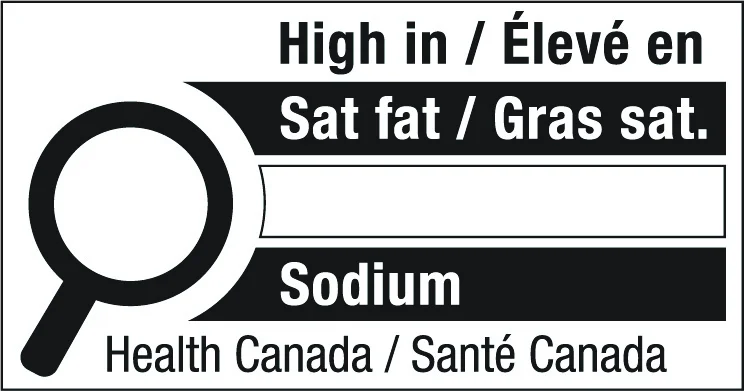The federal government is introducing a new food labelling system that will show you at a glance whether a product contains unhealthy levels of sodium, sugars and/or saturated fat. Heart & Stroke dietitian Carol Dombrow explains how this will change your trip to the grocery store.
What is front-of-package labelling?
Front-of-package (FOP) nutrition labelling is meant to help you know even more about the foods and beverages you choose at the grocery store. Packaged foods will be required, as of January 1, 2026, to show simplified nutrition information on the front of the box, bag or can, where it can easily be seen and compared with other products.
How does labelling work now in Canada?
Many foods and beverages feature prominent labels showing what are called ‘nutrient content claims’ — touting benefits such as “high in calcium” — or health claims such as, “a healthy diet low in saturated and transfat may reduce the risk of heart disease.”
However, a product that qualifies for this kind of claim may also be high in sugar or salt, which can increase your risk of chronic disease. Front-of-package labelling will change this scenario, providing upfront information, that enables you to make healthier choices, faster.
What are the changes the government is mandating?
Health Canada has recently introduced mandatory front-of-pack labelling for any packaged foods high in nutrients that are a public health concern, specifically:
- sugars
- sodium
- saturated fat
A food that contributes 15% or more of the daily value of any of these would have to show a label on the front of package. Fresh, whole foods such as vegetables, fruit, meat and fish, as well as some milk products, would not be labelled.
What will you see on a food product that has Front-of-Package labelling?

The new front-of-package nutrition symbol includes a magnifying glass, intended to act as a quick and easy visual clue to identify foods high in these three nutrients of public health concern: sugars, sodium and saturated fat. The front-of-package symbol will complement the Nutrition Facts table displayed on the back of food packages, to help Canadians make informed choices.
Why the focus on sugar, salt and saturated fats?
Eating foods high in these nutrients on a regular basis can lead to increased health risks such as obesity, high blood pressure and heart disease.
Canadian diets are dominated by these ultra-processed foods, like soft drinks, cookies and chicken nuggets, which add excess sodium, sugars and saturated fat to our diets. Canada’s Food Guide recommends limiting these foods and drinks because they are not part of a healthy eating pattern, and because recent research (2020) revealed that over one-third (35%) of Canadians had increased consumption of junk food.
Why is Heart & Stroke strongly supporting new front-of-package labelling?
Heart & Stroke supports this initiative for several reasons:
- It can help consumers select healthier foods and will really help people who have difficulty with the nutrition facts table found on the back of food packages. This could include people with low literacy, people with poor eyesight and people with limited English or French language comprehension. It can potentially reduce chronic disease, including heart disease and stroke.
- It will encourage manufacturers to develop healthier products and reformulate existing foods, resulting in a healthier food supply.
- People want to see this change! A recent poll found that 8 in 10 Canadians (81%) support the federal government requiring the packaged-food industry to include mandatory front-of-package alert labels on packaged foods indicating whether they are high in sugar, salt, and saturated fat when appropriate.
Heart & Stroke is pleased to see a single, standardized, mandatory front-of-package labelling system that is prominently displayed on the package.
The label should be easy to understand, consistently located and supported by a strong education program to help consumers get to know the new system.
The goal is to encourage Canadians to purchase more vegetables and fruit, whole grain foods and protein foods, and prepare them at home. And, eventually, see less heart disease and stroke in future generations.
- Read our position statement on front-of-package nutrition labelling.
- Learn more about healthy eating.
- Check out our heart-healthy recipes.
